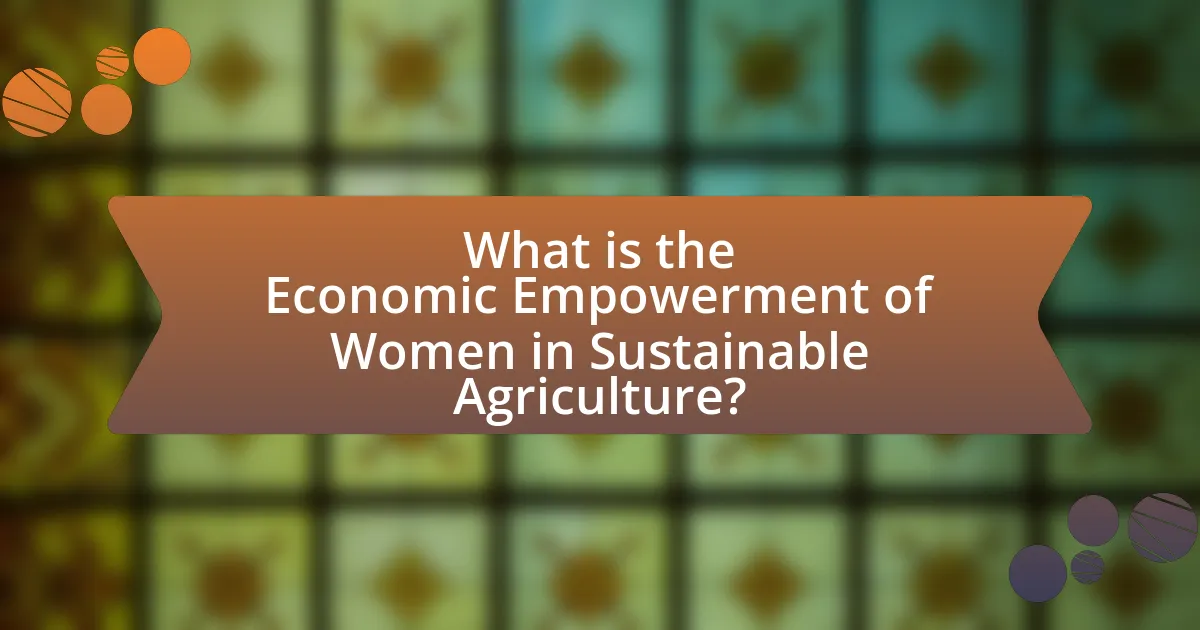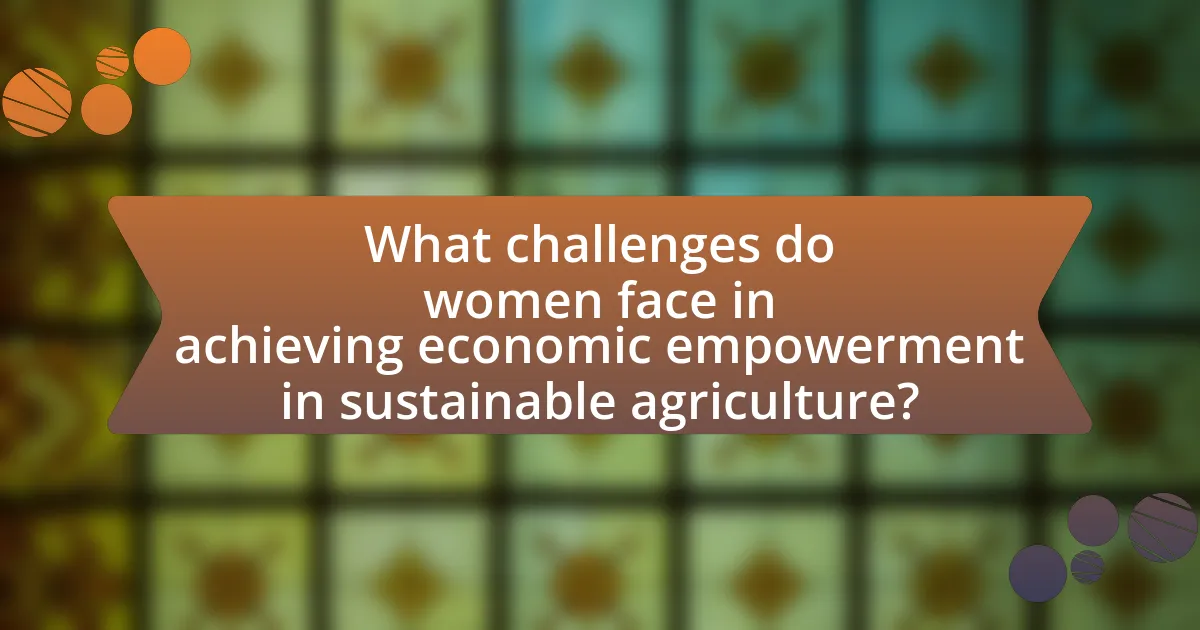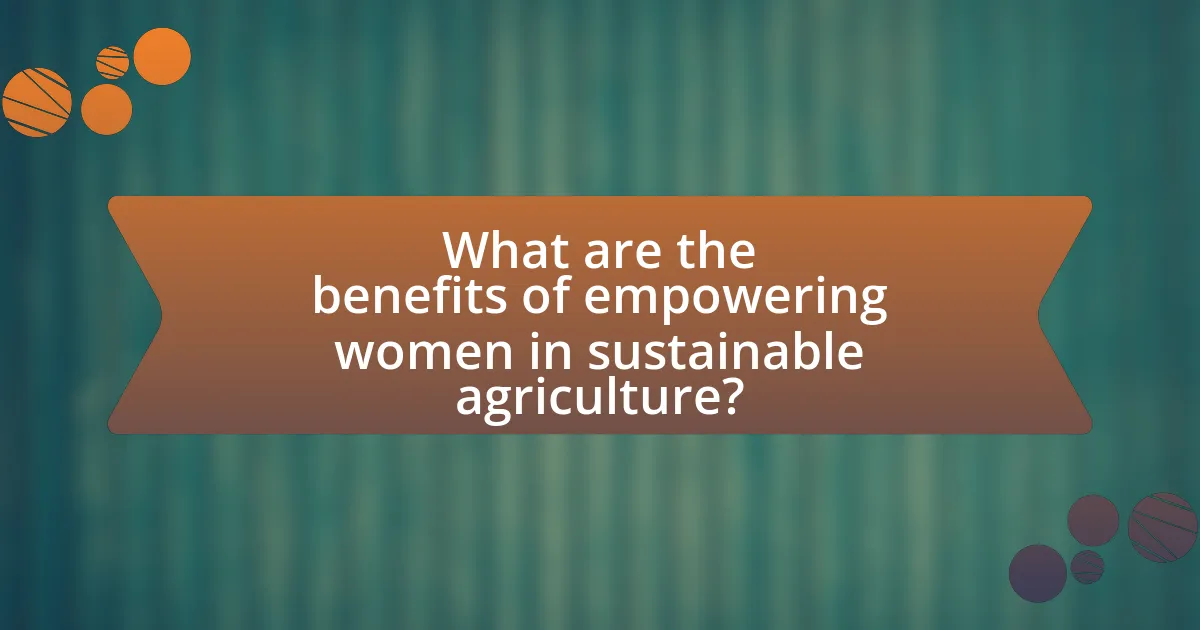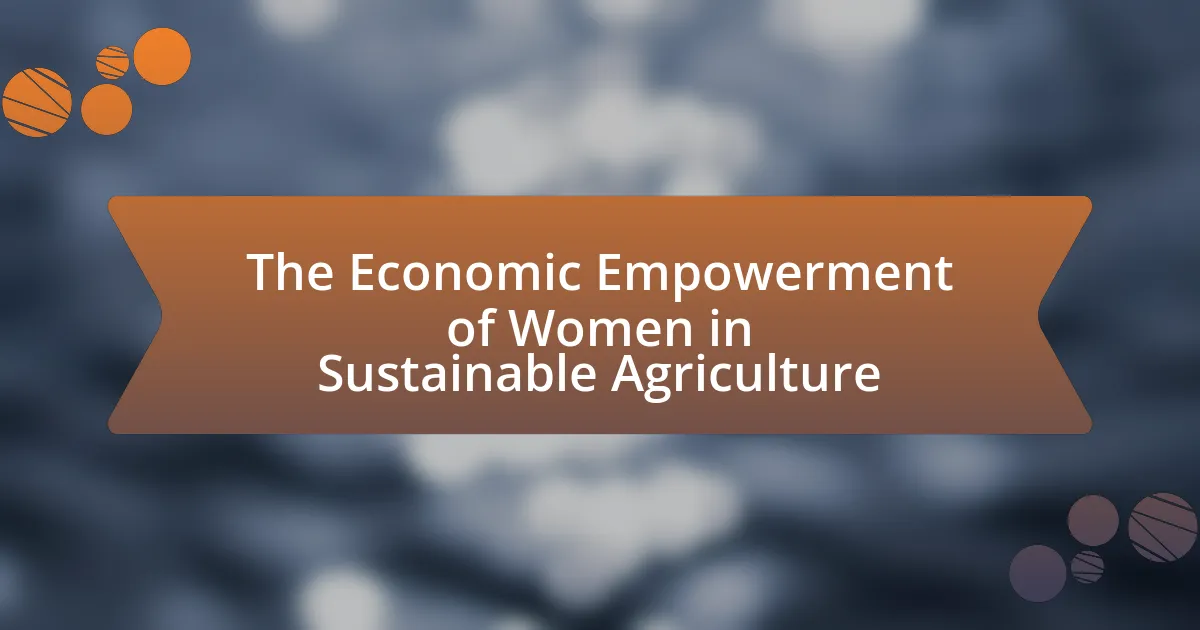The economic empowerment of women in sustainable agriculture is a critical process that enables women to make informed economic decisions within agricultural systems that prioritize environmental sustainability. This empowerment is essential as women represent a significant portion of the agricultural workforce, particularly in developing countries, where they often encounter barriers such as limited access to resources and markets. The article explores how economic empowerment manifests through increased access to resources, decision-making power, and income generation, highlighting key indicators and the role of women in sustainable practices. It also addresses the challenges women face, including cultural norms and economic obstacles, while discussing effective policies and initiatives that can enhance their empowerment and contribute to food security and community resilience.

What is the Economic Empowerment of Women in Sustainable Agriculture?
The economic empowerment of women in sustainable agriculture refers to the process by which women gain the ability to make and act on economic decisions within agricultural systems that prioritize environmental sustainability. This empowerment is crucial as women constitute a significant portion of the agricultural workforce, particularly in developing countries, where they often face barriers such as limited access to resources, training, and markets. Studies indicate that when women are economically empowered, agricultural productivity increases, leading to improved food security and economic growth. For instance, the Food and Agriculture Organization (FAO) reports that closing the gender gap in agriculture could increase yields on women’s farms by 20-30%, which would significantly enhance overall agricultural output and contribute to sustainable development goals.
How does economic empowerment manifest in sustainable agriculture?
Economic empowerment in sustainable agriculture manifests through increased access to resources, decision-making power, and income generation for women. Women engaged in sustainable agricultural practices often gain control over land, credit, and technology, which enhances their productivity and economic independence. For instance, a study by the Food and Agriculture Organization (FAO) indicates that if women had the same access to productive resources as men, they could increase yields on their farms by 20-30%, leading to improved food security and economic stability. This empowerment not only boosts individual livelihoods but also contributes to community development and sustainable agricultural practices.
What are the key indicators of economic empowerment for women in this sector?
Key indicators of economic empowerment for women in sustainable agriculture include access to financial resources, ownership of land, participation in decision-making processes, and the ability to influence agricultural practices. Access to financial resources is evidenced by women’s ability to secure loans and grants, which can be quantified through statistics showing increased funding for women-led agricultural initiatives. Ownership of land is critical, as studies indicate that women who own land have greater control over production and income, leading to improved livelihoods. Participation in decision-making processes is reflected in women’s involvement in cooperatives and agricultural organizations, where their voices contribute to policy changes. Lastly, the ability to influence agricultural practices is demonstrated through women’s engagement in sustainable farming techniques, which can be measured by the adoption rates of eco-friendly practices among women farmers.
How does sustainable agriculture contribute to women’s economic empowerment?
Sustainable agriculture contributes to women’s economic empowerment by providing them with access to resources, training, and markets that enhance their productivity and income. Women engaged in sustainable agricultural practices often benefit from improved agricultural techniques, which can lead to higher yields and better quality produce. For instance, a study by the Food and Agriculture Organization (FAO) found that women farmers who adopted sustainable practices increased their crop yields by up to 30%. Additionally, sustainable agriculture initiatives often include capacity-building programs that equip women with skills in business management and financial literacy, further enabling them to participate effectively in local and global markets. This empowerment not only boosts their economic status but also enhances their decision-making power within households and communities.
Why is the economic empowerment of women crucial for sustainable agriculture?
The economic empowerment of women is crucial for sustainable agriculture because it enhances productivity, promotes food security, and fosters environmental sustainability. Women constitute a significant portion of the agricultural workforce, particularly in developing countries, where they often manage smallholder farms. Empowering women economically allows them to access resources such as land, credit, and technology, which increases their agricultural output. For instance, the Food and Agriculture Organization (FAO) estimates that closing the gender gap in agriculture could increase yields on women’s farms by 20-30%, potentially reducing the number of hungry people by 100-150 million. Furthermore, empowered women are more likely to invest in sustainable practices and community welfare, leading to improved environmental outcomes and resilience against climate change.
What role do women play in sustainable agricultural practices?
Women play a crucial role in sustainable agricultural practices by being primary contributors to food production, resource management, and biodiversity conservation. They are responsible for a significant portion of agricultural labor globally, with estimates indicating that women produce between 60% to 80% of the food in developing countries. Their involvement in sustainable practices includes implementing agroecological methods, managing local seed varieties, and promoting organic farming techniques, which enhance soil health and reduce dependency on chemical inputs. Research shows that when women have equal access to resources and decision-making, agricultural productivity can increase by 20-30%, leading to improved food security and economic stability for communities.
How does empowering women impact food security and community resilience?
Empowering women significantly enhances food security and community resilience by increasing agricultural productivity and improving household nutrition. When women have access to resources, education, and decision-making power, they are more likely to invest in sustainable agricultural practices, leading to higher yields. For instance, a study by the Food and Agriculture Organization (FAO) found that closing the gender gap in agriculture could increase global food production by up to 30%. This increase in productivity directly contributes to food security, as families can access more diverse and nutritious food options. Furthermore, empowered women often play a crucial role in community networks, fostering collaboration and resilience against economic and environmental shocks. Their involvement in local governance and resource management strengthens community ties and enhances adaptive capacities, making communities more resilient to challenges such as climate change.

What challenges do women face in achieving economic empowerment in sustainable agriculture?
Women face significant challenges in achieving economic empowerment in sustainable agriculture, primarily due to systemic barriers such as limited access to resources, discriminatory practices, and inadequate support systems. These barriers manifest in various forms, including restricted access to land ownership, which affects women’s ability to cultivate and profit from agricultural activities. According to the Food and Agriculture Organization, women represent 43% of the agricultural labor force in developing countries but often lack equal rights to land and credit, which hinders their economic potential. Additionally, cultural norms and gender biases can restrict women’s participation in decision-making processes, further limiting their opportunities for empowerment.
What barriers hinder women’s participation in sustainable agriculture?
Barriers that hinder women’s participation in sustainable agriculture include limited access to resources, lack of education and training, cultural norms, and insufficient support from institutions. Limited access to resources, such as land, credit, and technology, restricts women’s ability to engage in sustainable practices effectively. According to the Food and Agriculture Organization, women own less than 20% of land globally, which significantly impacts their agricultural productivity. Lack of education and training further exacerbates this issue, as women often have fewer opportunities to acquire the necessary skills for sustainable farming. Cultural norms can also impose restrictions on women’s roles in agriculture, often prioritizing male participation. Lastly, insufficient institutional support, including policies that do not address gender disparities, limits women’s involvement in sustainable agriculture initiatives.
How do cultural norms affect women’s roles in agriculture?
Cultural norms significantly shape women’s roles in agriculture by dictating their access to resources, decision-making power, and participation in agricultural activities. In many societies, traditional gender roles assign women to specific tasks, often limiting them to subsistence farming while men engage in cash crop production, which is more economically rewarding. For instance, a study by the Food and Agriculture Organization (FAO) highlights that women perform 43% of the agricultural labor globally but often lack ownership rights to land, which restricts their ability to invest in and benefit from agricultural production. Furthermore, cultural beliefs may discourage women from participating in agricultural training programs or accessing financial services, further entrenching gender disparities in the sector.
What economic obstacles do women encounter in this field?
Women in sustainable agriculture face several economic obstacles, including limited access to financial resources, land ownership, and market opportunities. Research indicates that women often have less access to credit and financial services, which restricts their ability to invest in agricultural inputs and technologies. According to the Food and Agriculture Organization, women own only about 13% of land globally, which limits their agricultural productivity and economic independence. Additionally, women frequently encounter barriers in accessing markets due to social norms and lack of networking opportunities, further hindering their economic empowerment in this field.
How can these challenges be addressed to enhance women’s empowerment?
To enhance women’s empowerment in sustainable agriculture, challenges can be addressed through targeted policy interventions, access to resources, and education. Implementing gender-sensitive policies that promote equal access to land, credit, and technology is essential; for instance, the Food and Agriculture Organization reports that women farmers are 13% less likely to own land compared to men, which limits their economic potential. Providing training programs focused on sustainable agricultural practices can equip women with the necessary skills to improve productivity and income. Additionally, fostering women’s participation in decision-making processes at both community and organizational levels can ensure that their needs and perspectives are integrated into agricultural development strategies.
What policies can support women’s economic empowerment in agriculture?
Policies that can support women’s economic empowerment in agriculture include access to land ownership, financial services, and education. Access to land ownership enables women to secure their livelihoods and invest in agricultural production, as evidenced by studies showing that women who own land are more likely to improve their economic status. Financial services, such as microloans and credit, provide women with the necessary capital to start or expand agricultural enterprises, which has been shown to increase their income and economic independence. Education and training programs focused on agricultural skills enhance women’s productivity and decision-making abilities, leading to better outcomes in farming practices. Collectively, these policies create an enabling environment that fosters women’s participation and success in the agricultural sector.
How can education and training programs be tailored to assist women in agriculture?
Education and training programs can be tailored to assist women in agriculture by focusing on practical skills, access to resources, and addressing gender-specific challenges. These programs should include hands-on training in sustainable farming techniques, financial literacy, and leadership development to empower women as decision-makers in agricultural practices. For instance, the Food and Agriculture Organization (FAO) emphasizes that targeted training can increase women’s productivity by up to 30% when they have access to the same resources as men. Additionally, incorporating local knowledge and community involvement in program design ensures that the training is relevant and culturally appropriate, thereby enhancing its effectiveness.

What are the benefits of empowering women in sustainable agriculture?
Empowering women in sustainable agriculture leads to increased productivity and improved food security. Studies show that when women have equal access to resources, such as land, credit, and training, agricultural yields can increase by 20-30%. This boost in productivity not only enhances household income but also contributes to community resilience against climate change. Furthermore, women’s involvement in sustainable practices promotes biodiversity and environmental stewardship, as they often prioritize sustainable methods that benefit both their families and the ecosystem.
How does women’s empowerment contribute to sustainable agricultural practices?
Women’s empowerment significantly contributes to sustainable agricultural practices by enhancing productivity and promoting environmentally friendly methods. When women have access to resources, education, and decision-making power, they are more likely to adopt sustainable practices such as crop diversification and organic farming. Research indicates that women farmers can increase yields by 20-30% when provided with equal access to resources compared to their male counterparts. Furthermore, empowered women often prioritize community well-being and environmental sustainability, leading to practices that conserve biodiversity and improve soil health. This correlation is supported by the Food and Agriculture Organization, which highlights that closing the gender gap in agriculture could reduce the number of hungry people by up to 150 million.
What environmental benefits arise from women’s involvement in sustainable agriculture?
Women’s involvement in sustainable agriculture leads to significant environmental benefits, including enhanced biodiversity, improved soil health, and better water management. Research indicates that women often prioritize ecological practices, such as crop rotation and organic farming, which contribute to increased biodiversity and resilience in agricultural systems. For instance, a study by the Food and Agriculture Organization (FAO) found that women farmers are more likely to adopt sustainable practices that enhance soil fertility and reduce erosion, thereby improving soil health. Additionally, women’s management of water resources often results in more efficient irrigation practices, which can lead to reduced water waste and improved water quality. These practices collectively contribute to a more sustainable agricultural ecosystem, demonstrating the critical role women play in environmental stewardship within agriculture.
How does women’s economic empowerment influence community development?
Women’s economic empowerment significantly influences community development by enhancing economic growth, improving social structures, and fostering sustainable practices. When women gain access to resources, education, and opportunities, they contribute to increased household income and community wealth, which can lead to better health, education, and infrastructure. For instance, a study by the World Bank found that closing gender gaps in labor force participation could boost GDP by up to 25% in some countries. Furthermore, empowered women often invest in their families and communities, leading to improved social outcomes such as reduced poverty and enhanced community resilience. This multifaceted impact underscores the critical role of women’s economic empowerment in driving comprehensive community development.
What success stories exemplify the economic empowerment of women in sustainable agriculture?
Success stories that exemplify the economic empowerment of women in sustainable agriculture include the work of the Self-Employed Women’s Association (SEWA) in India, which has organized women farmers to improve their livelihoods through sustainable practices. SEWA has enabled over 1.5 million women to gain access to resources, training, and markets, resulting in increased income and improved food security. Another notable example is the Women’s Land Rights Program in Kenya, which has helped women secure land ownership and access to agricultural inputs, leading to a 30% increase in crop yields and enhanced economic stability for participating households. These initiatives demonstrate how empowering women in agriculture can lead to significant economic benefits and sustainable development.
What initiatives have proven effective in empowering women in this sector?
Initiatives that have proven effective in empowering women in sustainable agriculture include access to training programs, microfinance opportunities, and cooperative models. Training programs enhance women’s skills in sustainable farming practices, leading to increased productivity and income. For instance, the Food and Agriculture Organization (FAO) reports that women who receive agricultural training can increase their yields by 20-30%. Microfinance initiatives provide women with the financial resources needed to invest in their farms, enabling them to purchase seeds, tools, and technology. Research by the International Fund for Agricultural Development (IFAD) indicates that women who access microfinance are 30% more likely to improve their household income. Additionally, cooperative models allow women to pool resources, share knowledge, and access larger markets, which has been shown to improve their economic stability and bargaining power.
How can these success stories be replicated in other regions?
Success stories in the economic empowerment of women in sustainable agriculture can be replicated in other regions by implementing tailored training programs, establishing cooperative networks, and securing access to financial resources. Tailored training programs, such as those developed by organizations like the Food and Agriculture Organization, have shown that equipping women with specific agricultural skills leads to increased productivity and income. Establishing cooperative networks allows women to share resources, knowledge, and market access, as evidenced by successful models in countries like Kenya, where women’s groups have significantly improved their bargaining power and profitability. Additionally, securing access to financial resources through microfinance initiatives has been proven to enhance women’s ability to invest in sustainable practices, as demonstrated by the Grameen Bank model, which has empowered millions of women globally. These strategies collectively create an environment conducive to replicating success stories across diverse regions.
What practical steps can be taken to support the economic empowerment of women in sustainable agriculture?
To support the economic empowerment of women in sustainable agriculture, practical steps include providing access to financial resources, education, and training programs tailored to sustainable practices. Access to microfinance and credit enables women to invest in agricultural inputs and technologies, which can enhance productivity. Educational initiatives focused on sustainable farming techniques equip women with the knowledge to improve crop yields and manage resources efficiently. Additionally, establishing cooperatives allows women to pool resources, share knowledge, and access larger markets, thereby increasing their economic independence. According to the Food and Agriculture Organization, empowering women in agriculture can increase productivity by 20-30%, significantly contributing to food security and economic growth.
